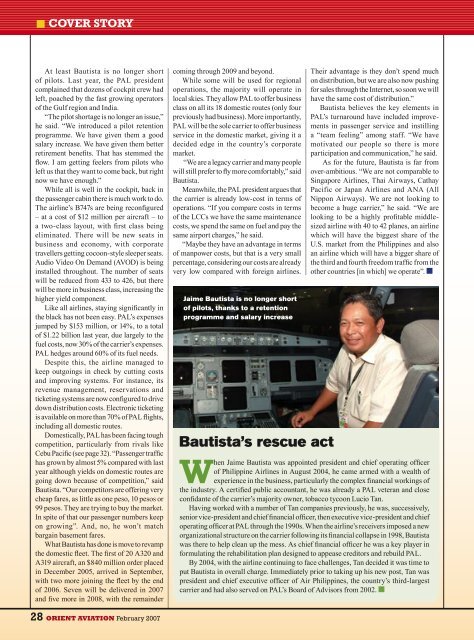Japan Airlines - Orient Aviation
Japan Airlines - Orient Aviation
Japan Airlines - Orient Aviation
- No tags were found...
You also want an ePaper? Increase the reach of your titles
YUMPU automatically turns print PDFs into web optimized ePapers that Google loves.
COVER STORYAt least Bautista is no longer shortof pilots. Last year, the PAL presidentcomplained that dozens of cockpit crew hadleft, poached by the fast growing operatorsof the Gulf region and India.“The pilot shortage is no longer an issue,”he said. “We introduced a pilot retentionprogramme. We have given them a goodsalary increase. We have given them betterretirement benefits. That has stemmed theflow. I am getting feelers from pilots wholeft us that they want to come back, but rightnow we have enough.”While all is well in the cockpit, back inthe passenger cabin there is much work to do.The airline’s B747s are being reconfigured– at a cost of $12 million per aircraft – toa two-class layout, with first class beingeliminated. There will be new seats inbusiness and economy, with corporatetravellers getting cocoon-style sleeper seats.Audio Video On Demand (AVOD) is beinginstalled throughout. The number of seatswill be reduced from 433 to 426, but therewill be more in business class, increasing thehigher yield component.Like all airlines, staying significantly inthe black has not been easy. PAL’s expensesjumped by $153 million, or 14%, to a totalof $1.22 billion last year, due largely to thefuel costs, now 30% of the carrier’s expenses.PAL hedges around 60% of its fuel needs.Despite this, the airline managed tokeep outgoings in check by cutting costsand improving systems. For instance, itsrevenue management, reservations andticketing systems are now configured to drivedown distribution costs. Electronic ticketingis available on more than 70% of PAL flights,including all domestic routes.Domestically, PAL has been facing toughcompetition, particularly from rivals likeCebu Pacific (see page 32). “Passenger traffichas grown by almost 5% compared with lastyear although yields on domestic routes aregoing down because of competition,” saidBautista. “Our competitors are offering verycheap fares, as little as one peso, 10 pesos or99 pesos. They are trying to buy the market.In spite of that our passenger numbers keepon growing”. And, no, he won’t matchbargain basement fares.What Bautista has done is move to revampthe domestic fleet. The first of 20 A320 andA319 aircraft, an $840 million order placedin December 2005, arrived in September,with two more joining the fleet by the endof 2006. Seven will be delivered in 2007and five more in 2008, with the remaindercoming through 2009 and beyond.While some will be used for regionaloperations, the majority will operate inlocal skies. They allow PAL to offer businessclass on all its 18 domestic routes (only fourpreviously had business). More importantly,PAL will be the sole carrier to offer businessservice in the domestic market, giving it adecided edge in the country’s corporatemarket.“We are a legacy carrier and many peoplewill still prefer to fly more comfortably,” saidBautista.Meanwhile, the PAL president argues thatthe carrier is already low-cost in terms ofoperations. “If you compare costs in termsof the LCCs we have the same maintenancecosts, we spend the same on fuel and pay thesame airport charges,” he said.“Maybe they have an advantage in termsof manpower costs, but that is a very smallpercentage, considering our costs are alreadyvery low compared with foreign airlines.Jaime Bautista is no longer shortof pilots, thanks to a retentionprogramme and salary increaseBautista’s rescue actTheir advantage is they don’t spend muchon distribution, but we are also now pushingfor sales through the Internet, so soon we willhave the same cost of distribution.”Bautista believes the key elements inPAL’s turnaround have included improvementsin passenger service and instillinga “team feeling” among staff. “We havemotivated our people so there is moreparticipation and communication,” he said.As for the future, Bautista is far fromover-ambitious. “We are not comparable toSingapore <strong>Airlines</strong>, Thai Airways, CathayPacific or <strong>Japan</strong> <strong>Airlines</strong> and ANA (AllNippon Airways). We are not looking tobecome a huge carrier,” he said. “We arelooking to be a highly profitable middlesizedairline with 40 to 42 planes, an airlinewhich will have the biggest share of theU.S. market from the Philippines and alsoan airline which will have a bigger share ofthe third and fourth freedom traffic from theother countries [in which] we operate”.When Jaime Bautista was appointed president and chief operating officerof Philippine <strong>Airlines</strong> in August 2004, he came armed with a wealth ofexperience in the business, particularly the complex financial workings ofthe industry. A certified public accountant, he was already a PAL veteran and closeconfidante of the carrier’s majority owner, tobacco tycoon Lucio Tan.Having worked with a number of Tan companies previously, he was, successively,senior vice-president and chief financial officer, then executive vice-president and chiefoperating officer at PAL through the 1990s. When the airline’s receivers imposed a neworganizational structure on the carrier following its financial collapse in 1998, Bautistawas there to help clean up the mess. As chief financial officer he was a key player informulating the rehabilitation plan designed to appease creditors and rebuild PAL.By 2004, with the airline continuing to face challenges, Tan decided it was time toput Bautista in overall charge. Immediately prior to taking up his new post, Tan waspresident and chief executive officer of Air Philippines, the country’s third-largestcarrier and had also served on PAL’s Board of Advisors from 2002.28 ORIENT AVIATION February 2007








![OAMag-V7N4-Cover [Converted] - Orient Aviation](https://img.yumpu.com/48598575/1/190x255/oamag-v7n4-cover-converted-orient-aviation.jpg?quality=85)







